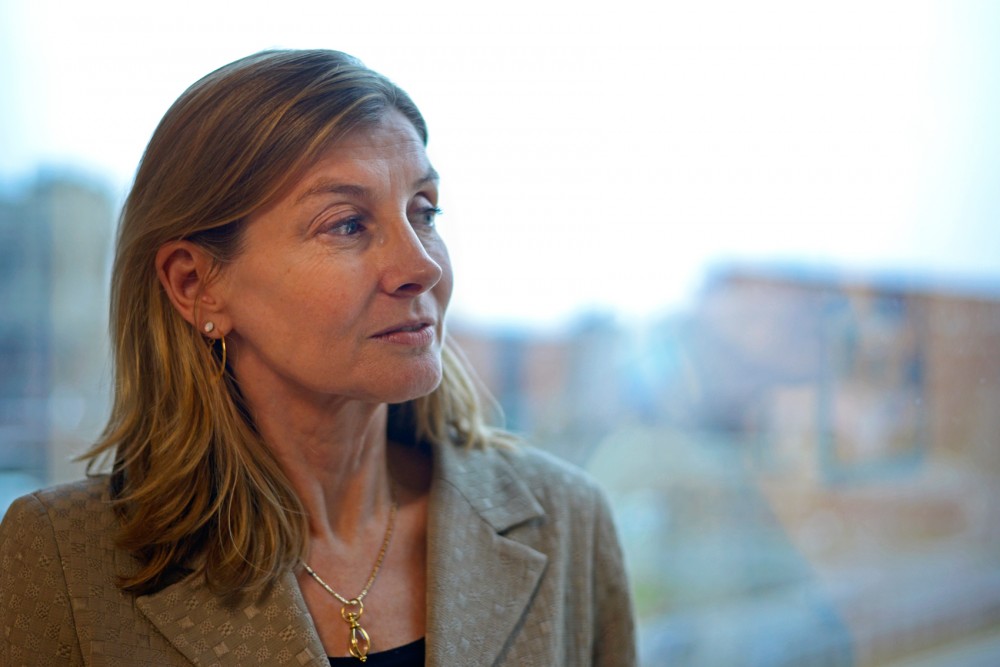Nancy Lindborg, first female president and CEO of the United States Institute of Peace, provided her insight on the roots of world conflict in a speech at the University of Minnesota’s Humphrey School of Public Affairs Tuesday.
The Institute of Peace is an independent and nonpartisan organization under Congress created to mitigate violent conflict around the world.
Lindborg sat down with the Minnesota Daily for a question-and-answer about the challenges of maintaining peace in conflicted regions and what students can do to make a difference.
Let’s [talk about] your work at USIP. What do you do there, specifically, and do you have any ongoing projects?
We’re really dedicated to the proposition that peace is, in fact, possible — that it’s quite practical, and it’s essential for national and international security. USIP both works directly in conflict zones, in places like Iraq, Afghanistan, Pakistan, Nigeria and other places, equipping people, organizations and governments with specific tools and evidence and information for how to build peace, [like] negotiation, mediation, dialogues. Then, we connect it to research and training. … Then we connect that with policy making in the United States.
How do you choose a specific approach? How do you look at something and decide to focus on that certain issue?
That is the hardest thing for any organization to do well. If you scan over the last couple of decades, the majority of conflicts are happening inside states, not as much between states. So, that means what is most important is helping people and organizations and governments in countries that are least able to manage conflict so that it doesn’t become violent and focus in those places. We acknowledge that conflict is a fact of life. There will always be conflict, and so when we say, “prevent conflict,” what we really mean is prevent conflict from becoming violent. … Sometimes conflict can even be transformative. It can enable extremely profound important change to happen. … That’s how you want to approach conflict and help other countries not be torn apart by the differences, but to come out in a more positive place.
How do you successfully keep peace or prevent conflict in a region that has so many contributing factors to it, like Syria, for example?
The first is recognize that peace building is no longer just the domain of diplomats and that you need to engage at every level of society to build peace. … We need to build peace from the bottom up, as well as from the top down. The third piece is that it takes times. So nobody should think that [Syria’s war] is going to be over anytime soon. However, we need to collectively … work now before the fighting stops to help communities heal because one of the big problems is, in these conflicts, it’s not just the infrastructure, like the houses and bridges that get destroyed; it’s the community fabric. Especially in a community where you have multiple ethnicities or religious groups like you do in Syria. It will take a very long time to rebuild that trust.
What are the biggest challenges in creating and maintaining peace?
These are highly complicated places, and you can’t walk in thinking you have a play book because you did somewhere else. … I think that the biggest challenge is getting clear that it’s got to be locally driven, and the action has to happen as a result of what local leaders, local communities, want for themselves. … There are core, shared values at the heart of humanity. … It’s not just peace as an absence of conflict. It’s peace in terms of having a prosperous, peaceful life with justice and security.
What will you be covering in your speech at the Humphrey school?
I’ll talk about some of these issues. We’re at a point where there is this sense if you’re reading the news that we have a heightened conflict and crisis around the world. These [are] historic levels of displacement because of violent conflict, 60 million people, four raging civil wars in the Middle East. So there is this sense of, “What do you do about that?” and the humanitarian system is stretched and overburdened. What I want to talk about this afternoon is the importance of looking at why are these people displaced, why are there these civil wars, how do you focus upstream of the crisis and look at the dynamics in a core group of countries that are the source of huge percentage of the refugees? We need to invest in a different way of approaching change in these countries. A lot of it … [includes] equipping everyday people with the tools to build peace at the community level, to enable that to connect up with national processes and understanding that it’s going to take time. If you look at the demographics of most of those, what I call, “fragile countries,” … a huge percentage of their population is under the age of 30. The median age in a swath of those counties is 17 to 21. [Young people] have to be a part of the conversation, and it is their world that they have to help solve.
What do you think University students can do?
I think, first of all, is stay engaged. I think whether you’re working in Minneapolis or you decide to work somewhere else in this country or another country, there are lots and lots of ways in which you can be a part of building peace through looking at building bridges with communities you may not otherwise engage with. Especially with the power of social media. There is so many ways in which you are building peace every day or not. We need really need to reclaim peace as common vision and common goal. We
really can’t afford not to.
A











